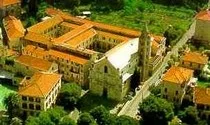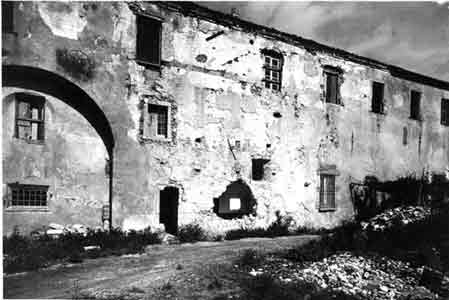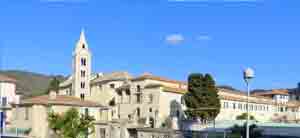phoenix
Documents
PHOENIX
Sunday of Mary Most Holy Mother of God (01/01/2023)
A SUNDAY IN SEPTEMBER IN 1944
 In this Feast dedicated to Peace, it may seem inappropriate to talk about a war that hit our Abbey hard…
In this Feast dedicated to Peace, it may seem inappropriate to talk about a war that hit our Abbey hard…Instead, it is certainly meaningless who has unleashed a war just beyond the eastern borders of our central Europe, causing mourning, pain and destruction not many thousands of kilometers from the door of our house.
The explosions of this cruel war in Ukraine are casting flashes that help us to grasp some reflections of what happened to us about eighty years ago, on an ordinary Sunday in September 1944.
The monastic community of Finalpia was engaged in the Sanctuary (under the watchful eye of the Blessed Santa Maria di Pia, who for centuries has been looked upon as the true Lady of the Marquisate of Finale), when an allied plane dropped two bombs which fell into the garden, about ten meters from the east wing of the Abbey. 

The target was not us, but the nearby bridges (the medieval one and above all the railway one), their damage would have caused serious problems to the Nazi-fascist Axis troops in Liguria.
The explosion was so great that two palm trees that stood where the two bombs had fallen were uprooted and even ended up on the roof of the monastery kitchen.
The perimeter walls of the building held, but a real upheaval occurred inside.
The interiors of all the rooms on the east side collapsed, from number 9 to the south facade of the building.
The collapse also involved the reception hall below and the entire Staircase area.
Sunday of the Baptism of the Lord (08/01/2023)
This Sunday we have the opportunity to continue talking about the effects of the bombing of the Abbey, which took place in September 1944.
 The floor of the long corridor on the 1st floor did not give way, while in some walls of the rooms on its west side (in particular in the monastic chapel) only cracks appeared, which were immediately and easily remedied by Don Leandro Montini himself (who had finished painting the Monastic Chapel as soon as 1943): he did so because there were no signs at all that the stability of the premises had been compromised.
The floor of the long corridor on the 1st floor did not give way, while in some walls of the rooms on its west side (in particular in the monastic chapel) only cracks appeared, which were immediately and easily remedied by Don Leandro Montini himself (who had finished painting the Monastic Chapel as soon as 1943): he did so because there were no signs at all that the stability of the premises had been compromised.The two photographs taken after the bombing reveal only a few cracks in the walls of little importance.
The undersigned has seen the photo of part of the long corridor on the first floor, taken immediately after the bombing: it was all a pile of rubble from which the splintered sections of the beams of what had once been the roof were protruding.
The photo had been taken from the unharmed part of the same corridor, with the lens aimed at the large window (or what remained of it).
(Let's hope that this photo hasn't been permanently lost and sooner or later it pops up).
2nd Sunday of Ordinary Time (January 15, 2023)
Let's go back to talking about the effects of the bombing that affected the Abbey in September 1944.
 The roof of the east side of the corridor, that above chambers No. 9 to the large window of the south facade of the Abbey, did not collapse completely and managed to conceal the disaster that had occurred below. We see in the photo on the left, a glimpse of this battered roof.
The roof of the east side of the corridor, that above chambers No. 9 to the large window of the south facade of the Abbey, did not collapse completely and managed to conceal the disaster that had occurred below. We see in the photo on the left, a glimpse of this battered roof.As soon as possible, the restoration and rebuilding of the collapsed parts began, without however compromising the regularity of the rhythm of monastic life.
For this purpose a temporary wall was placed, made with wooden planks and cardboard, which isolated the monks community from the team of workers engaged in the restoration.
This last room (VIII) still retains, inside, the vaulted ceiling, originally from the sixteenth century. From room IX to the large window at the end of the corridor, the rooms now have only ordinary ceilings (squared and flat), as is normally used even today.
An observation that may be of interest.
The window pane of the corridor, which can be glimpsed in the photo - in the foreground - at the top, roughly at the height of room VII, is still splayed, as was the custom in 1500. The remaining window panes, up to the end of the corridor ( both those on the right and on the left) are no longer splayed, but perfectly squared (power and banality of the concrete, generously used in the restoration).
The partition was removed only after the restoration work was completed.
4th Sunday in Ordinary Time (January 29, 2023)
We wrote that the 2 bombs, which fell on a canopy of the Abbey garden on a Sunday in September 1944, had caused serious damage to a wing of the monastery, but that the monks had come out completely unharmed, because they were engaged in the Sanctuary for Sunday religious services.
Some of our monks, in fact, were not present in our monastery.
Called up to military service during that conflict, some were military chaplains, while others were in captivity because they had already been captured by allied troops.
There was also one reported missing in a war zone.
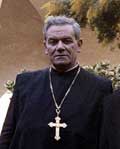 The military chaplain was the future Abbot of Finalpia P. Salvatore Marsili, born in 1910, thirty years old in the years of the
The military chaplain was the future Abbot of Finalpia P. Salvatore Marsili, born in 1910, thirty years old in the years of the  conflict 1940/45.
conflict 1940/45.Here we see him with the cassock, the stars and the ranks of lieutenant, while he poses in a souvenir photo with some simple soldiers and some graduates, probably from his department.
We don't know where the photo was taken, only that the military train was stationary on the tracks somewhere in the railway system during a normal transfer. The uniforms of the soldiers and the fact that they did not carry weapons, excludes that they were in a war zone.
Fr Ildebrando Minzolini had entered Finalpia, which had just reopened, at a very young age. He made his religious profession on March 12, 1907. He had to participate in the Libyan war of 1911 and then in the First World War of 1915/18. Returning definitively to the monastery, he 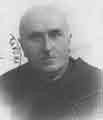 completed his studies and was ordained a priest in December 1923. Called up for military service during the 1940/45 conflict, he worked as chaplain at the Lancia military hospital in Finalpia.
completed his studies and was ordained a priest in December 1923. Called up for military service during the 1940/45 conflict, he worked as chaplain at the Lancia military hospital in Finalpia.
 completed his studies and was ordained a priest in December 1923. Called up for military service during the 1940/45 conflict, he worked as chaplain at the Lancia military hospital in Finalpia.
completed his studies and was ordained a priest in December 1923. Called up for military service during the 1940/45 conflict, he worked as chaplain at the Lancia military hospital in Finalpia.5th Sunday in Ordinary Time (January 29, 2023)
Fr Domenico Ranieri (1902-1979)
Called up in 1940, as a military chaplain, he carried out his service in Libya.
 First, taken prisoner in Egypt, he was taken to a concentration camp in India. It was later transferred to
First, taken prisoner in Egypt, he was taken to a concentration camp in India. It was later transferred to an English Benedictine Monastery.
He returned to Finalpia only in 1945.
Fr Bonifacio Vota (1913-1943?)
Born in Casalette (TO), he was ordained a priest on 14 August 1938 in Finalpia.
We reproduce here the souvenir photo of the participants in the First Mass of Fr. Bonifacio Vota.
On 15 July 1940 he was recalled to the Alpini in Pinerolo and then on 15 November he was discharged. But on 19 January 1941 he was called up again.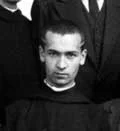

Abbot Placido Colabattista (born in 1919) one day recounted that, when Fr. Bonifacio was chaplain in Pinerolo, he had written to his military superiors to be sent back to the monastery or sent directly to the front, because in Pinerolo he saw himself as completely useless. So since the beginning of June he has been in Russia with the Taurinense Alpine Division of the Italian Army (ARMIR). From a letter to his brother dated October 1, 1942  it appears that he is on the Don, in the hospital, where he also takes care of Russian prisoners.
it appears that he is on the Don, in the hospital, where he also takes care of Russian prisoners.
 it appears that he is on the Don, in the hospital, where he also takes care of Russian prisoners.
it appears that he is on the Don, in the hospital, where he also takes care of Russian prisoners.He studies Russian with a prisoner and points out that the prisoners love the Italians because they are treated well by them. In December 1942, he was in Krinitza, and on 8 December he recited Vespers with two other chaplains.
Shortly before Christmas of that year - notes a chaplain - he left the isba to go and celebrate for his sick people, but he didn't arrive!
They must have picked it up and taken it away by surprise.
Since then he has not given any more news and is considered untraceable by the military command. Uncertain news make him present among the retreating Germans as an interpreter and, probably, he died in 1943.
He was awarded the Silver Medal for Military Value.
The phoenix is a mythological bird present in the folklore of various peoples considered capable of controlling fire and
to be reborn from his own ashes after death.
